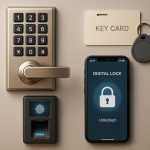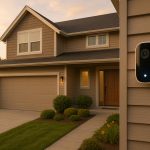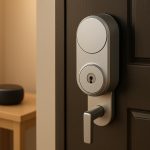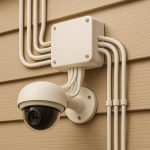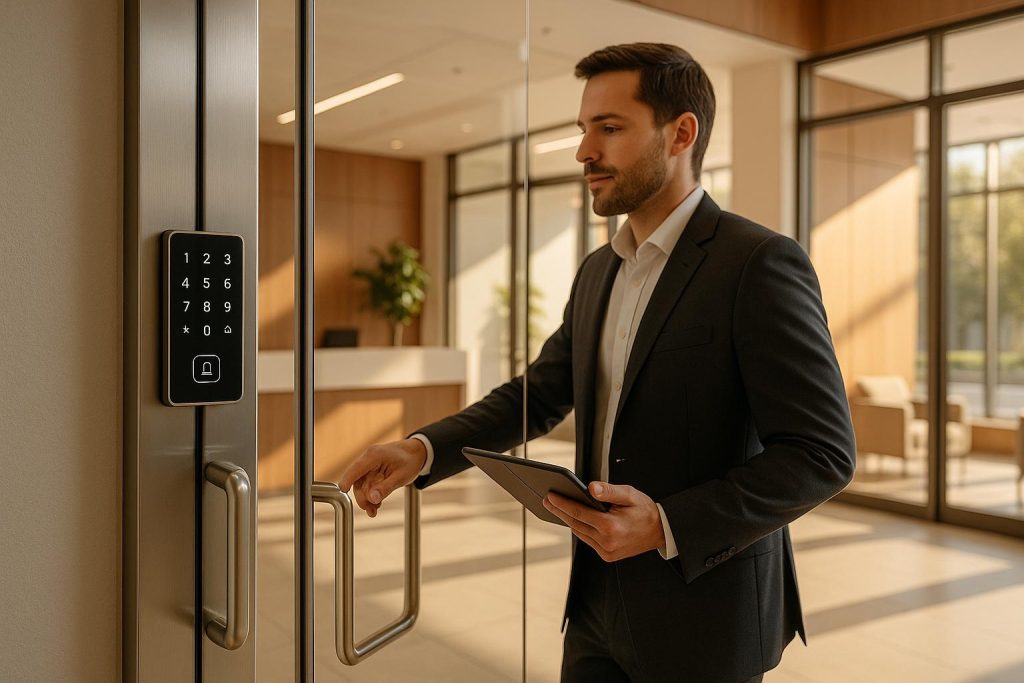Keyless entry systems are reshaping how businesses manage access. By replacing physical keys with digital credentials like key cards, mobile apps, PIN codes, or biometrics, companies gain better control, improved security, and operational efficiency. Unlike traditional locks, these systems allow instant updates, detailed access logs, and remote management, solving common issues like lost keys, unauthorized access, and costly rekeying.
Key Benefits:
- Instant Access Management: Grant or revoke access remotely in seconds.
- Enhanced Security: Prevent duplication and monitor all entries with activity logs.
- Cost Savings: Eliminate rekeying expenses and reduce downtime.
- Emergency Features: Lockdown or unlock doors remotely during crises.
Switching to keyless systems not only strengthens security but also simplifies daily operations, making them a smart investment for businesses of all sizes.
What is Door Access Control System? Basic Knowledge in Security
Problems with Physical Key Security Systems
Physical key systems might seem straightforward and familiar, but they come with a host of vulnerabilities that can jeopardize security and disrupt operations. As businesses grow, these challenges only become more pronounced, prompting many to explore modern digital alternatives.
Lost or Stolen Keys Are a Major Risk
When a key goes missing, your facility’s security is immediately at risk until you replace or rekey the locks. Unlike digital credentials, which can be deactivated instantly, a lost physical key remains a liability until the necessary (and often time-consuming) steps are taken to secure the area. This delay leaves your business exposed to potential breaches.
The situation becomes even more precarious if a master key is stolen. A single master key can grant access to multiple areas, putting sensitive information, equipment, or inventory at risk. For smaller businesses with limited resources, addressing such vulnerabilities quickly can be particularly challenging.
Another concern is unauthorized duplication. Physical keys can sometimes be copied without proper oversight, creating an ongoing security risk. These duplicates may remain in circulation indefinitely, further complicating efforts to maintain control.
Access Management Challenges
Keeping track of who has access to what becomes increasingly difficult with physical keys. Each employee, contractor, or visitor needs their own key, and maintaining accurate records of access permissions is prone to human error.
When employees leave, there’s no guarantee they’ll return their keys – or that they haven’t made duplicates. Digital systems solve this issue by allowing instant deactivation of access credentials. Temporary access for contractors or short-term staff is also problematic with physical keys, as they don’t easily accommodate time-limited permissions.
For businesses of even moderate size, managing a large number of keys for different access levels can quickly become overwhelming. Key handoffs during shift changes often lead to confusion or delays, further complicating day-to-day operations.
The Cost and Disruption of Rekeying
Rekeying locks and replacing keys can be expensive and disruptive, especially for businesses with multiple entry points. These expenses can add up quickly, creating a significant financial burden over time.
The process of rekeying itself is inconvenient. It might need to be scheduled outside of regular business hours to avoid disrupting operations, or it could temporarily restrict access to important areas. Either scenario impacts employee productivity and customer service.
Additionally, physical key systems struggle to keep up with high-traffic areas or locations exposed to harsh conditions. These environments often require frequent updates or maintenance – something that physical systems simply can’t handle as efficiently as digital solutions. This lack of flexibility highlights the growing need for more responsive, technology-driven access management systems.
How Keyless Entry Systems Solve Security Problems
Keyless entry systems tackle common security challenges by replacing traditional keys with digital, real-time access solutions. These systems not only address the risks of lost keys and unauthorized duplication but also streamline access management, boosting both security and efficiency.
Digital Credentials and Instant Access Control
With keyless systems, physical keys are swapped for secure digital credentials that can be managed centrally. These credentials come in several forms, like key cards, smartphone apps, PIN codes, or biometric scans.
One major advantage is instant control. If an employee leaves or a credential is compromised, administrators can immediately deactivate access. Temporary access is also a breeze – whether it’s for contractors, delivery workers, or temporary staff, credentials can be set to expire automatically after a specific time or task.
Another critical benefit is the prevention of unauthorized duplication. Unlike physical keys that can be easily copied, digital credentials require system authentication, ensuring each one is unique and traceable.
This level of control and flexibility makes digital systems ideal for managing secure and efficient access while enabling comprehensive tracking.
Activity Tracking and Monitoring
Keyless systems don’t just manage access – they also provide detailed insights into who is entering and exiting. These systems maintain comprehensive access logs, recording every entry and exit, along with timestamps and user details. This kind of visibility is impossible with traditional keys.
With real-time monitoring, security teams can track access attempts as they happen. Alerts can be triggered for unusual activity, such as entry attempts outside business hours or multiple failed login attempts. Notifications can be sent directly to managers’ devices, allowing for immediate action.
Access logs also serve a dual purpose: they help businesses meet compliance requirements and provide critical evidence for investigations, whether for insurance claims or legal matters. For example, logs can reveal who was present during a specific incident.
Additionally, these systems use pattern recognition to identify potential risks. If an employee starts accessing areas outside their usual scope or exhibits unusual behavior, the system can alert managers before problems escalate.
Emergency Response Features
Keyless entry systems are particularly valuable during emergencies, where speed and control are paramount. In a crisis, security personnel can initiate a remote lockdown, securing the entire facility from anywhere with internet access. This feature ensures occupants are protected within seconds during threats.
On the flip side, emergency unlock features allow for rapid evacuation. Firefighters or first responders can use override codes to unlock all exits, ensuring quick and safe evacuation during fires or medical emergencies.
These systems also integrate seamlessly with other security measures. For instance, if a fire alarm is triggered, the keyless system can automatically unlock exit doors while keeping perimeter doors secure. Security cameras can also activate automatically to monitor unusual access events.
Some systems include panic button functionality, where employees can send emergency alerts through their mobile apps or key cards. This immediately notifies security teams and can lock down specific areas to contain threats.
The ability to manage access remotely adds another layer of flexibility. Whether responding to after-hours access requests or managing an emergency from home, remote control ensures that security measures remain effective without disrupting business operations.
Business Benefits of Keyless Entry Systems
Keyless entry systems help businesses save money, simplify operations, and keep up with growth.
Lower Costs Compared to Physical Lock Systems
With keyless entry, rekeying costs become a thing of the past. Digital credentials can be deactivated instantly, saving money and time. Managing access is streamlined through a centralized system, where one administrator can oversee permissions for numerous employees from a single dashboard – no need for locksmith visits. Plus, emergency lockouts are avoided since authorized personnel can grant access remotely.
Smoother Daily Operations
Beyond cost savings, keyless systems make day-to-day operations more efficient. Managers can grant temporary access to contractors or delivery personnel without leaving their desks, avoiding the hassle of physical key exchanges. Mobile management tools let them approve after-hours or weekend access requests on the spot, ensuring operations stay on track. Integration with HR systems further simplifies the process by automating access updates as employees are hired or leave, freeing up time for staff to focus on their main responsibilities.
Seamless Expansion for Growing Businesses
Keyless entry systems are designed to grow with your business. Adding new access points is often straightforward, as many systems work with your existing door infrastructure. Cloud-based platforms make it easy to manage multiple locations from one central dashboard, ensuring consistent security policies across all sites. These systems also offer flexible permission settings to accommodate various user needs, from seasonal workers to executives. Regional managers can handle local access independently, while retrofit-friendly designs minimize disruptions during upgrades, letting businesses scale security at their own pace.
sbb-itb-643e28e
Keyless Entry vs. Physical Locks: Side-by-Side Comparison
Choosing between keyless entry systems and traditional physical locks is more than just a matter of preference – it’s a decision that can impact daily operations and long-term costs. To make an informed choice, it’s essential to understand how these two options stack up against each other. Below is a straightforward comparison to help you weigh the pros and cons.
Comparison Table: Features, Costs, and Benefits
| Factor | Keyless Entry Systems | Physical Locks |
|---|---|---|
| Initial Setup Cost | Higher upfront investment for hardware and installation | Lower initial cost for basic lock hardware |
| Ongoing Expenses | Minimal maintenance; no need for key cutting or rekeying | Recurring costs for key duplication, rekeying, and locksmith services |
| Access Management | Remote changes and management of numerous credentials | Manual key distribution; requires physical presence for updates |
| Security Features | Activity tracking, time-based restrictions, instant revocation | Basic physical security with no monitoring capabilities |
| Scalability | Easily expands across multiple locations with centralized control | Requires separate lock installations and key management for each location |
| Integration Options | Works with video surveillance, alarms, and HR systems | Operates independently; no digital integration |
| Emergency Response | Remote access granting and automated lockdown capabilities | Requires on-site key handling |
| User Convenience | Multiple authentication methods (e.g., PINs, cards, mobile apps) | Single method: physical key possession |
Key Considerations for Businesses
While keyless entry systems come with a higher initial price tag, they save businesses money over time by eliminating recurring costs like key duplication, rekeying, and locksmith services. This makes them a cost-effective option in the long run.
Keyless systems also bring flexibility to the table. Businesses can grant temporary access instantly, adjust permissions for specific areas, and set time-based restrictions for after-hours security. Traditional locks, on the other hand, require physical handling for any changes, which can be time-consuming and less efficient.
Another standout advantage of keyless systems is their ability to manage multiple locations through a single, cloud-based dashboard. This centralized control streamlines operations, especially for businesses with multiple properties or offices. In contrast, physical locks require individual management, which can quickly become a logistical headache.
Lastly, keyless entry systems seamlessly integrate with modern security infrastructure, such as video surveillance and alarm systems. This creates a unified and automated approach to security, offering businesses greater oversight and peace of mind – something traditional locks simply can’t provide.
Sherlock’s Locksmith: Your Local Keyless Entry Expert
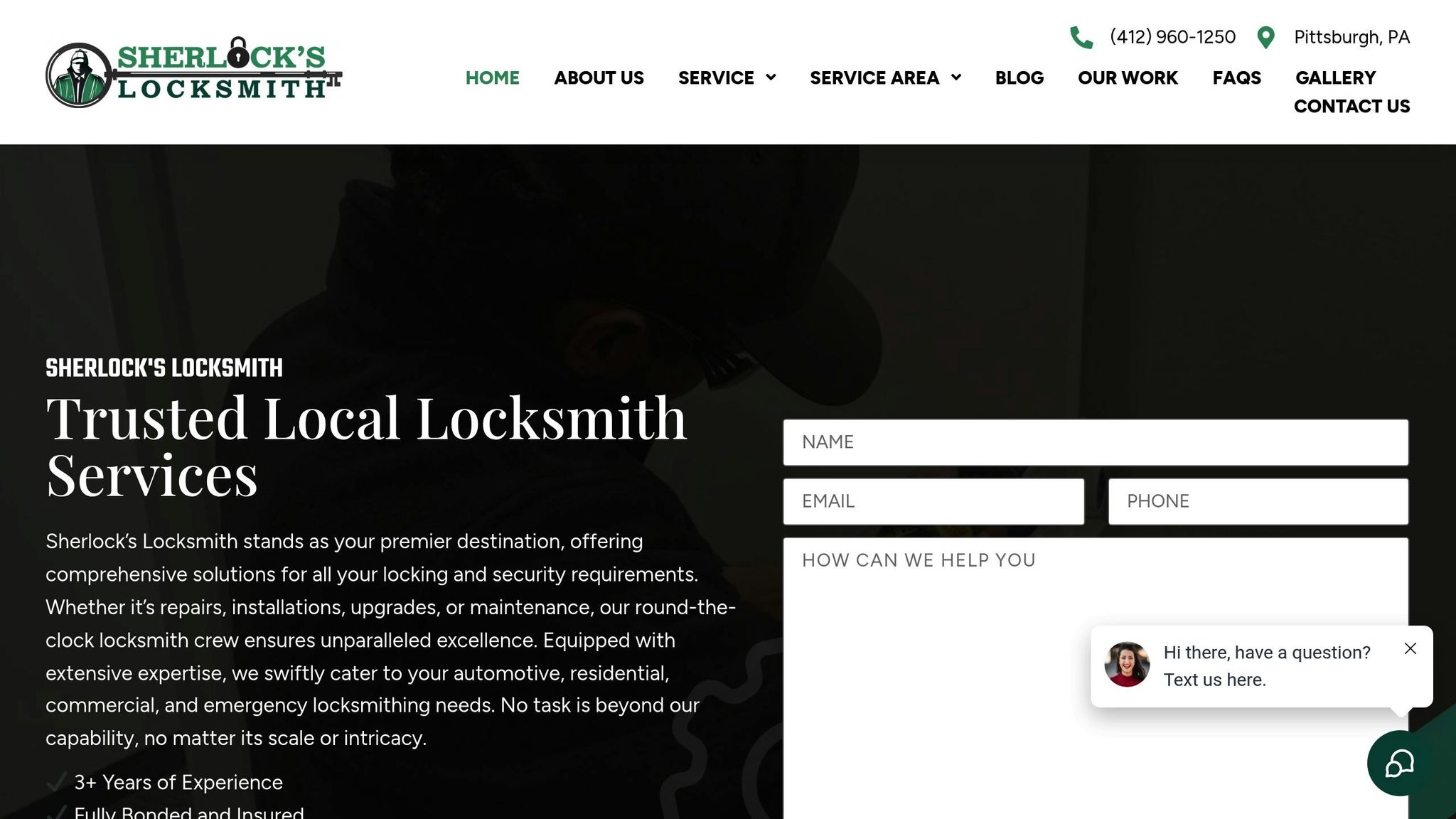
Upgrading your business security with a keyless entry system is a smart move, but it all starts with choosing the right locksmith. For Pittsburgh businesses, that means finding a provider who understands both traditional locksmithing and modern security technology. With local expertise, Sherlock’s Locksmith offers services tailored specifically to the unique needs of Pittsburgh’s commercial landscape.
Comprehensive Security Solutions for Pittsburgh Businesses
Sherlock’s Locksmith provides a full range of keyless entry solutions designed for businesses in Pittsburgh. Whether you need a basic access control system or a cutting-edge biometric lock, they handle everything from the initial consultation to ongoing maintenance.
But they don’t stop at installations. Their services include customized access control systems to meet the specific needs of your business – whether you’re securing a single office or managing multiple locations. They also specialize in master key systems, which give businesses the flexibility of combining traditional and keyless access options. Need help figuring out what works best for your setup? Their security consulting services guide you toward the right mix of technology.
Pittsburgh’s diverse business environment calls for customized solutions, and Sherlock’s Locksmith delivers. From Strip District warehouses to Downtown office buildings, they design systems that fit your operations. Whether it’s managing employee access at a 24-hour facility or securing sensitive areas in a professional office, their tailored approach improves both security and efficiency.
Their installation process covers advanced electronic security options, such as keyless entry systems, biometric locks, and alarm system integration. By offering a unified security solution, they eliminate the need to piece together components from multiple providers. Plus, their team ensures your staff is trained on how to use the system effectively, setting you up for smooth daily operations from the start.
Certified Technicians and 24/7 Support You Can Count On
Security challenges don’t stick to a 9-to-5 schedule, which is why Sherlock’s Locksmith offers 24/7 emergency locksmith services. Their certified technicians are always ready to tackle issues like system malfunctions or emergency lockouts, keeping your business downtime to a minimum.
Their mobile locksmith service ensures expert assistance comes directly to your location. Equipped with state-of-the-art tools, their technicians can handle anything from traditional lock challenges to advanced keyless system repairs. Whether it’s extracting a broken key, resolving a lockout, or fixing a malfunctioning system, they’ve got you covered.
For keyless entry systems, having certified technicians is critical. These systems require specialized knowledge for proper installation, programming, and maintenance. Sherlock’s Locksmith keeps its team trained on the latest security technologies, ensuring your system gets the expert care it needs over its lifetime. This level of expertise not only enhances your security but also ensures your operations run smoothly.
Switching to a keyless entry system is a big step, but Sherlock’s Locksmith makes it easier with their reliable, local support. Instead of dealing with a distant call center or waiting days for help, you get fast, on-the-ground assistance from professionals who know your system inside and out. For businesses that can’t afford downtime, this reliability is just as critical as the advanced features of the system itself.
Conclusion: Better Security and Convenience with Keyless Entry
Switching to keyless entry systems can reshape how businesses handle security and streamline everyday operations. By eliminating the issues tied to lost or misplaced keys, these systems bring a new level of convenience and control.
With digital credentials, businesses can instantly adjust access permissions and maintain detailed audit trails, reducing security risks and simplifying operations during staff changes. Employees no longer need to juggle key handovers for odd-hour access, while managers can rely on detailed logs to ensure compliance and monitor activity. These features not only enhance security but also create a smoother workflow, making it easier for businesses to scale without interruptions.
As businesses grow, keyless systems adapt effortlessly. Instead of managing physical keys, administrators can handle access remotely, making it simpler to open new locations or adjust permissions on the fly. This flexibility is especially valuable in fast-paced or expanding operations.
Modern keyless systems are built with reliability in mind. Features like battery backups and mobile app integration ensure continuous access, even during power outages or credential issues. With professional installation and ongoing support, businesses can count on consistent performance.
For businesses in Pittsburgh, adopting keyless entry systems means stronger security and more efficient operations tailored to local needs. Many have already seen improvements in both protection and day-to-day management. Combining advanced control, ease of use, and dependable technology, keyless entry is a forward-thinking choice for businesses looking to safeguard their assets while improving how they operate.
FAQs
How do keyless entry systems provide better security than traditional locks?
Keyless entry systems bring a higher level of security by incorporating advanced features like encryption, tamper detection, and electronic monitoring. These technologies make them much more difficult to breach compared to traditional locks. Plus, unlike physical keys – which can be lost, duplicated, or stolen – keyless systems rely on alternatives such as codes, keycards, or biometric authentication, eliminating those vulnerabilities entirely.
Another advantage is that many keyless systems maintain detailed access logs, recording who enters and exits a building and at what time. This not only helps deter unauthorized access but also provides useful data that businesses can use to strengthen their security strategies.
What are the costs involved in upgrading a business to a keyless entry system?
The price of upgrading your business to a keyless entry system can vary significantly based on the system’s complexity and features. On average, you can expect costs to fall between $500 and $6,000 per door. Simpler systems usually range from $500 to $1,500 per door, while more advanced options with additional features can cost anywhere from $2,500 to $6,000 per door.
Beyond the system itself, there are additional costs to consider. These include hardware, installation, and access devices like key fobs or access cards, which typically range from $4 to $25 each. While the initial investment might feel steep, keyless entry systems provide long-term advantages, including improved convenience, enhanced security, and lower maintenance expenses, making them a smart option for businesses.
How do keyless entry systems work with existing security setups, and what advantages do they offer for businesses?
Keyless entry systems integrate effortlessly with your current security setup, offering a blend of convenience and protection. These systems provide controlled access, remote management, and detailed entry logs, giving you greater visibility over who enters your business and when. Plus, by doing away with traditional keys, you eliminate the risks tied to lost or stolen keys.
The advantages are clear: better security, smoother operations, and savings on rekeying or replacing locks. On top of that, keyless systems can work alongside other security tools like video surveillance and occupancy tracking, creating a more connected and efficient security solution tailored to your business.



